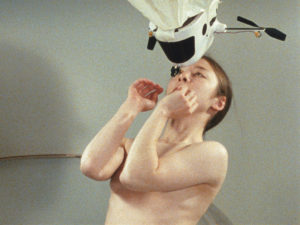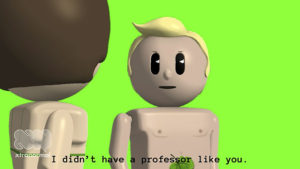Video Art for a Jaded Generation

A twirling glitter ball is competing for attention with the captivating pop music in the innermost room of the comprehensive video art exhibition The New Human at Moderna Museet in Stockholm. Video projections cover three of the walls of the room with films flickering by in the tempo of the music. The artist, Robert Boyd, has in the piece Xanadu, put together cuts of archive films representing the evil of man’s many faces.
Acts of terrorism, riots, assasinations och dictators passes by in a raging tempo. Clips form September 11 are mixed with shimmering pink clouds and dancing pop stars. The effect of Xanadu is insidous, yet dramatic. The result physical more than intellectual. The horrific content of the pictures clashes with the vision of the room, the music making the viewers want dance to the malevolent imagery.
The work comprises the reality many of us know and recognize, the evil that we encounter in the news and the media, in sharp contrast to the escapism we seek in the world of entertainment, TV series we loose ourselves in and the cheerfulness of YouTube clips and GIFs that permeates our every day lives. We know it all but don’t actually feel a lot of it, a survival mechanism of a jaded generation.
The curatorial intent of Moderna Museet’s exhibition ”The New Human”, is somewhat grandiose. The exhibition makes it’s starting point in the contemporary, global conditions that shapes us as human beings. All of the works have been created after the millennium 2000. Characterized by an exploration of the living conditions, of the systems and worldviews that shapes us. September 11th brought on a collapse of the beleif in our modern, Western society, the fortress of security we had carefully constructed was razed. Not because of the number of casualties or the way the terror act was executed but it was an attack on the very heart of the Western world, it’s core and it’s holiest mammon. The worldview since then is signified by war, terror and extreme nationalist forces. The evolution of technology influnces us increasingly and the global digitilisation gives us instant access to information. People are travelling freely across the globe while the ones that need it the most are excluded through political and literal walls.
To envision a total picture of humanity is an overwhelming project, and this exhibition’s intentions feels at the same time grandious and almost impossible. On the other hand, the works are both nuansed and multifaceted, if not an answer to the question, a start and an important exploration of what it means to be human today.
Several pieces of the exhibition focuses on different aspects of how we, as individuals, interact with the world around us. Santiago Mostyn’s piece, Delay, addresses the search for identity in which we can follow the artist wandering around in Stockholm city. At Stureplan he engages with young men his own age, men with blonde hair and nice outfits. Typically ”Swedish” men. He touches and moves them. Using his own body in search of his own identity in relation to the men he encounter. It’s beautiful and tender and yet an invasion of someone’s private sphere. Some of the men Santiago Mostyn approaches don’t seem to be bothered, looking startled, more than anything. Others are obviously uncomfortable with a strange man putting his hand on their cheek and letting a lock of their hair slide through his fingers. There’s a tension to the piece, like the trembling heat of hot asphalt, almost physically noteable.
Soft Materials, by Daria Martin, is another piece that deals with just that, the body’s relation to the world. In this work, people and robots are performing a fragile, improvised choreography. The robots movements are influenced by the humans, they don’t have any programmed robot brains from before and learn from the dancers.
Here, as well, there is a tension between the greceful tactile and the unheimliche, the discomfort that arises from the insecurity about the robot’s actual ability of perception.

Frances Stark, My Best Thing, 2011 (film still)
© Frances Stark, Courtesy of the artist and Gavin Brown’s enterprise, New York
Frances Stark also explores the way in which we relate physically to the world in the work My Best Thing. In Starks case, it’s about finding ourselves in a state without bodies, where we live outside the body and through other mediums. She has collected material from virtual dating online and created a film where lego-like creatures are having sex and discussing philosophy.
These doll-like beings with computerized voices also renders a feeling of unheimliche. They’re not lifelike in any way but their consciousness can still be questioned since their interaction is based on the conversations and what’s actually happening, let alone virtual.
The artist Tomáš Rafa’s different works that are displayed in The new Human addresses the situation of refugees around the globe. The piece also deals with extreme nationalism and violent riots. The sense of recognition is so acute that it feels like I’m watching the news. These kinds of images has intensly influenced our worldview the latest years. Common reactions to these events is an angry emoji on Facebook. It tells us quite a lot about our generation that the media mogul has developed the functions of reacting with anger and sadness to complement the usual like.
We are, in many respects, a jaded generation.

